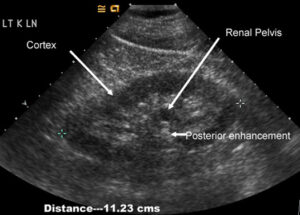
Introduction:
– Renal ultrasound is commonly used to assess chronic kidney disease (CKD) patients. Some sonographic parameters like kidney length, cortical echogenicity, and cortical thickness correlate with renal function.
– However, the accuracy of these crude parameters is limited. Weighting them towards cortical echogenicity may improve their ability to detect renal dysfunction and histological changes.
– The aim was to evaluate the performance of crude and composite (weighted for cortical echogenicity) ultrasound parameters in predicting histological changes and low estimated glomerular filtration rate (eGFR).
Methods:
– 112 CKD patients underwent renal ultrasound and biopsy.
– Kidney length, length/height ratio, cortical thickness were measured.
– Cortical echogenicity was graded relative to liver/spleen echogenicity.
– Weighted parameters were created by multiplying the crude values by empirically-derived echogenicity weighting factors.
– Ability of parameters to identify high creatinine, low eGFR, and histological changes was assessed using ROC analysis.
Results:
– Weighting ultrasound parameters towards cortical echogenicity improved their accuracy for detecting renal dysfunction and histological changes compared to crude values.
– The kidney length/height ratio weighted for echogenicity (w-KL/H) performed best, with an AUROC >0.8 for predicting high creatinine and low eGFR.
– w-KL/H also had the highest AUROC for detecting semi-quantitative grades of glomerular sclerosis, tubular atrophy and interstitial fibrosis.
– A w-KL/H cutoff ≤0.43 had 94.8% sensitivity for detecting severe chronic histological changes.
Discussion:
– Weighting sonographic measurements by cortical echogenicity significantly improved their diagnostic performance.
– w-KL/H was superior to crude or other weighted parameters for identifying renal dysfunction and histological damage.
– It could serve as a non-invasive triage tool to detect significant renal disease prior to biopsy.
– Limitations include qualitative echogenicity assessment and lack of other potential confounding factors.
Conclusion:
The newly derived w-KL/H index showed a close relationship with degree of histological changes in CKD patients. Routine calculation of w-KL/H may help non-invasively identify significant renal disease and guide therapeutic decisions.
In summary, the research demonstrated the potential clinical utility of a composite renal ultrasound parameter (w-KL/H) that accounts for cortical echogenicity in evaluating CKD severity. The strengths include a relatively large sample, correlation with biopsy findings, and quantitative analysis. Potential limitations were also discussed. Overall, it follows the standard structure of an original research paper.
